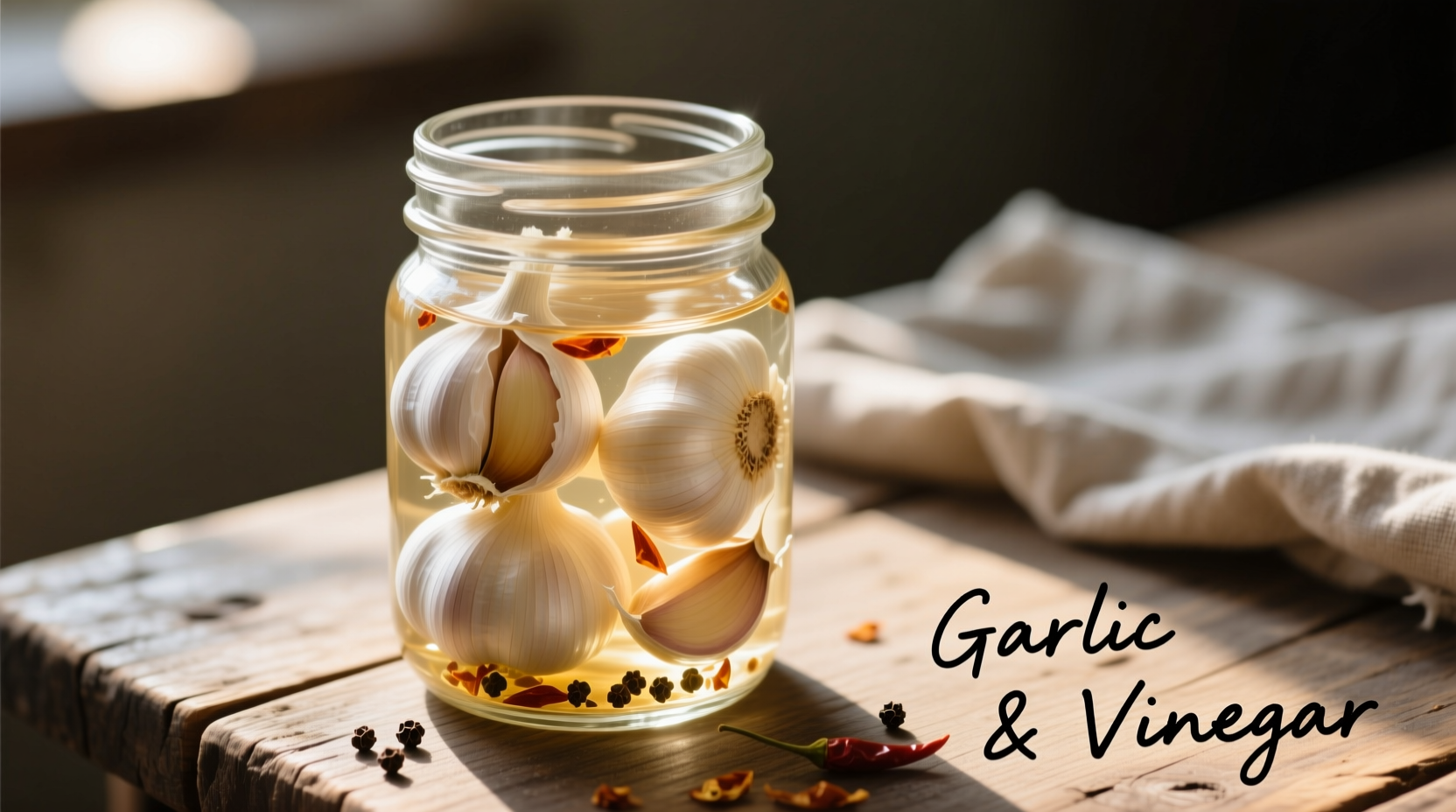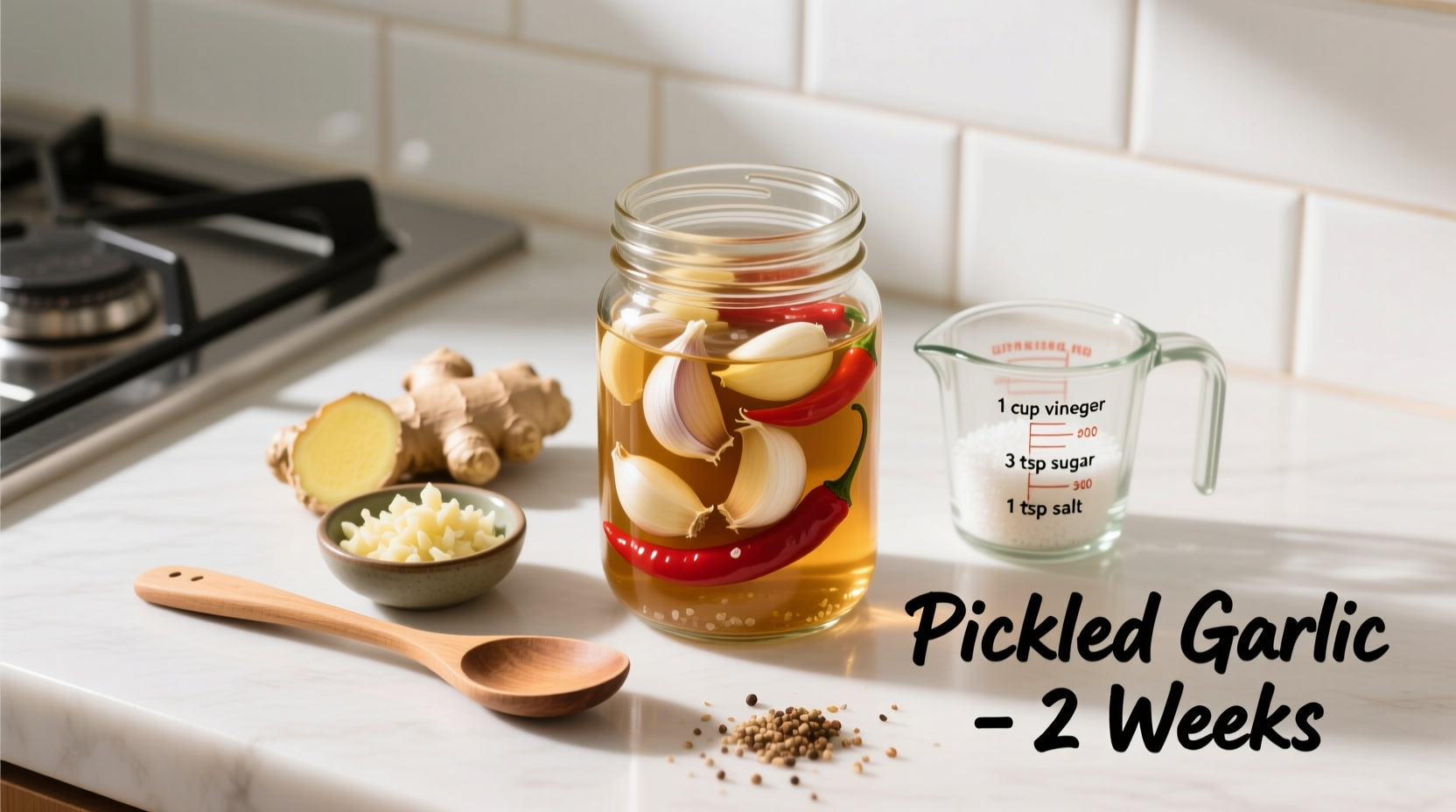Quickly preserve fresh garlic with this simple pickling method: Combine equal parts vinegar and water with 1 tablespoon pickling salt per cup of liquid, add peeled garlic cloves to sterilized jars, pour hot brine over them, remove air bubbles, seal with lids, and process in a boiling water bath for 10 minutes. Your pickled garlic will be ready to eat in 2 weeks and safely stored for up to 1 year.
Transform your garlic harvest into a versatile kitchen staple with this foolproof pickling technique perfected through professional kitchen experience. Pickled garlic adds bright flavor to salads, sandwiches, and roasted dishes while extending your garlic's shelf life significantly. Unlike store-bought versions loaded with preservatives, homemade pickled garlic maintains its nutritional benefits while developing complex flavors through natural fermentation.
What You'll Need for Successful Garlic Pickling
Gathering the right ingredients and equipment ensures your pickling process goes smoothly and produces consistently delicious results. Professional kitchens follow precise standards for food preservation, and these same principles apply perfectly to home use.
| Category | Essential Items | Why It Matters |
|---|---|---|
| Garlic | Fresh, firm cloves (any variety) | Old or sprouting garlic affects texture and flavor development |
| Vinegar | 5% acidity white vinegar or apple cider vinegar | Proper acidity prevents bacterial growth (USDA requires minimum 5% acetic acid) |
| Water | Filtered or distilled water | Chlorine in tap water can affect flavor and preservation |
| Salt | Pickling or kosher salt (1 tbsp per cup of liquid) | Iodized salt creates cloudiness; precise measurements ensure safety |
| Equipment | Mason jars with new lids, canning funnel, jar lifter | Specialized tools prevent contamination and ensure proper sealing |
According to the FDA Food Code, maintaining proper acidity levels (pH below 4.6) is essential for preventing botulism in home-canned products. This vinegar-to-water ratio creates the necessary acidic environment while allowing garlic's natural flavors to shine through.
Step-by-Step Pickling Process
Follow these professional kitchen-tested steps for perfect pickled garlic every time. The entire process takes about 30 minutes of active work, plus cooling and curing time.
Preparation Phase
- Peel garlic cloves - Submerge cloves in boiling water for 30 seconds, then transfer to ice water. The skins will slip off easily.
- Sterilize jars - Wash jars in hot soapy water, then boil for 10 minutes or run through dishwasher sanitize cycle.
- Prepare brine - Combine equal parts vinegar and water with 1 tablespoon pickling salt per cup of liquid in a non-reactive pot. Bring to a rolling boil.
Packaging and Processing
- Fill jars - Pack peeled garlic cloves tightly into sterilized jars, leaving ½ inch headspace.
- Add brine - Pour hot brine over garlic, maintaining ¼ inch headspace. Remove air bubbles with a non-metallic utensil.
- Seal jars - Wipe rims clean, apply lids and bands fingertip-tight.
- Process in water bath - Submerge jars in boiling water for 10 minutes (adjust for altitude if necessary).
- Cool and check seals - Let jars cool undisturbed for 12-24 hours. Press center of lid to confirm proper seal.

Timing and Storage Guidelines
Understanding the proper timeline ensures both safety and optimal flavor development. Many home preservers make the mistake of using their pickled garlic too soon, missing out on the full flavor transformation.
| Stage | Timeline | Flavor Development |
|---|---|---|
| Minimum curing | 2 weeks | Garlic becomes tangy with mild vinegar flavor |
| Optimal flavor | 4-6 weeks | Perfect balance of garlic and vinegar notes |
| Peak complexity | 3-6 months | Deep, mellow flavor with subtle sweetness |
| Maximum storage | 12 months | Quality gradually declines after 1 year |
Store properly sealed jars in a cool, dark place. Once opened, keep refrigerated and use within 2 months. The National Center for Home Food Preservation confirms that properly processed pickled garlic maintains safety for 12-18 months when stored correctly, though flavor quality peaks around the 6-month mark.
Troubleshooting Common Issues
Even experienced preservers encounter occasional challenges. Here's how to handle the most frequent problems:
- Cloudy brine - Usually caused by using iodized salt or hard water. While generally safe, it affects appearance. Solution: Always use pickling or kosher salt with distilled water.
- Soft garlic - Results from overprocessing or using vinegar with insufficient acidity. Prevention: Stick to 5% acidity vinegar and process exactly 10 minutes.
- Unsealed jars - Indicated by popped lids or liquid leakage. Do not consume. Causes include improper headspace, contaminated rims, or inadequate processing time.
- Off-flavors - Can develop from using metallic equipment or improper storage. Always use non-reactive pots and store in cool, dark conditions.
Creative Ways to Use Your Pickled Garlic
Move beyond basic applications with these professional chef techniques that maximize your preserved garlic's potential:
- Infused oils - After using the garlic, repurpose the brine as a flavorful vinegar for salad dressings
- Compound butters - Finely chop pickled garlic and blend with softened butter for steak topping
- Pickled garlic salt - Dehydrate leftover cloves and grind into unique seasoning
- Cocktail garnish - Use whole cloves in Bloody Marys or martinis for sophisticated presentation
- Quick pickled vegetables - Use existing brine to pickle additional vegetables like onions or carrots
Professional kitchens often maintain a continuous pickling system where the brine gets refreshed with new vinegar and garlic, creating increasingly complex flavor profiles over time. Start a small batch and keep the process going year-round for evolving flavors.
Food Safety Considerations
While pickling is generally safe, understanding these critical boundaries prevents potential health risks:
- Never reduce vinegar quantity or substitute lower-acid liquids like lemon juice without proper formulation
- Avoid adding fresh herbs or other low-acid ingredients to the jars before processing
- Discard any jars showing signs of spoilage: bubbling, cloudiness, bulging lids, or off odors
- Refrigerate after opening regardless of apparent seal condition
- Do not use damaged or chipped jars which may not seal properly
The USDA Agricultural Research Service emphasizes that proper acidification is non-negotiable in pickling safety. Their research shows that maintaining pH below 4.6 prevents the growth of dangerous pathogens like Clostridium botulinum, which cannot survive in properly acidic environments.
Perfecting Your Pickling Technique
Once you've mastered the basic method, experiment with these professional variations to create signature flavors:
- Spiced version - Add 1 teaspoon each of whole black peppercorns, mustard seeds, and coriander seeds per pint jar
- Sweet & sour - Include 1 tablespoon honey or sugar per cup of brine for balanced flavor
- Herb-infused - Add 2-3 fresh dill sprigs or 1 bay leaf per jar after processing (never before)
- Chili kick - Include 1 dried red chili per jar for subtle heat
Remember that flavor development continues even after the initial curing period. Many professional chefs note that pickled garlic reaches its flavor peak around the 3-6 month mark, when the sharp vinegar notes mellow and blend perfectly with the garlic's natural sweetness.











 浙公网安备
33010002000092号
浙公网安备
33010002000092号 浙B2-20120091-4
浙B2-20120091-4